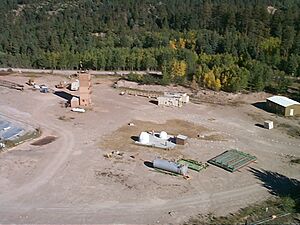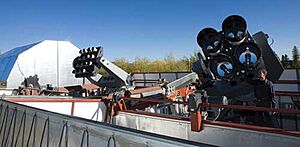Fenton Hill Observatory facts for kids
Fenton Hill Observatory is a special science place in the Jemez Mountains of New Mexico. It's run by the Los Alamos National Laboratory, which is a big research center. This observatory is about 35 miles (56 km) west of Los Alamos. It covers about 30 acres (12 hectares) and has many different experiments and telescopes.
The observatory is also known as Technical Area 57 (TA-57). It's located high up at 8,700 feet (2,652 meters) above sea level. This high location is great for looking at space because it's far away from city lights, which cause light pollution. Los Alamos National Laboratory uses this land with permission from the Forest Service. It's close to Fenton Lake State Park.
Contents
How Fenton Hill Observatory Began
This site was first used for a different science project. It was for something called Hot Dry Rock energy. This project, which started in 1974, tried to create electricity from the heat inside the Earth. It was one of the first attempts at geothermal power. The project ran on and off until 1995, when it was stopped. The land was then supposed to go back to the Forest Service.
However, in late 1995, scientists from Los Alamos had a new idea. They met and suggested turning Fenton Hill into a research station. This new station would be for astronomy, Earth sciences, and educational programs. A group was formed to help make this happen. The University of California's Institute for Nuclear and Particle Astrophysics and Cosmology (INPAC) also helped with building the new observatory.
Los Alamos has a history of important discoveries in space science. In 1973, a satellite called Vela was built by Los Alamos. It was designed to check for nuclear tests in the atmosphere. But it also found something unexpected: short flashes of gamma-rays coming from space. These "gamma-ray bursts" are still a mystery today and are studied a lot by scientists. The REACT telescope was the first gamma-ray telescope built at Fenton Hill. It got funding in 1996 and was finished in 1998.
Fenton Hill Observatory also had a program for high school students. It was called the Earthwatch Student Challenge Awards Program. For five summers, from 1997 to 2001, talented students came to the observatory. They used telescopes, special cameras, and computers. They learned about the sky and helped study the best places for telescopes in the Jemez Mountains.
REACT Telescope
REACT stands for Research and Education Automatically Controlled Telescope. It was the first telescope built at Fenton Hill to find gamma-ray bursts. It was completed between 1997 and 1998.
REACT has a special ability: when other instruments detect a gamma-ray burst, REACT quickly moves. It then takes many one-minute pictures to try and catch any light signals that happen at the same time as the burst. This telescope works by itself. It's inside a dome that can sense the weather and closes automatically when it rains.
ROTSE Telescopes
The ROTSE project is part of a big science effort around the world. ROTSE stands for Robotic Optical Transient Search Experiment. The first telescope, ROTSE-I, is no longer used.
The ROTSE-III telescope is designed to quickly look at gamma-ray bursts. These bursts are detected by satellites and other instruments. ROTSE-III first responded to a burst on December 11, 2002. It has four robotic telescopes, each about 0.45 meters (1.5 feet) wide. Together, they can see a large area of the sky. ROTSE can get information from NASA satellites. This allows it to point its cameras toward a burst event as it happens. It can respond to a burst in less than 10 seconds!
RAPTOR System
The RAPTOR system is a group of special telescopes. RAPTOR means Rapid Telescopes for Optical Response. These telescopes are made to find and follow objects that change quickly in the sky. This includes gamma-ray bursts and near-earth objects (asteroids or comets that come close to Earth).
A team at Los Alamos built RAPTOR. The system has six robotic observatories. Most of them (RAPTOR-A, -S, -P, -K, and -T) are at Fenton Hill. One, RAPTOR-B, is about 38 miles (61 km) away at the Los Alamos Neutron Science Center. All the telescopes are connected and controlled by one main computer.
The older RAPTOR telescopes (A, B, S, and P) each have two parts. They have a wide-field telescope and a narrow-field telescope. They are mounted on platforms that can turn to any part of the sky in under 3 seconds. This makes them some of the fastest moving telescopes ever built. The wide-field telescopes can see a very large area. They can cover the whole sky in just eleven sections. Each telescope actually has two cameras, giving them a kind of 3D vision. They can also zoom in.
When RAPTOR is watching the sky, it takes two pictures. If it sees something interesting, it zooms in with its narrow-field telescopes for a closer look.
The newest RAPTOR telescopes are RAPTOR-K and RAPTOR-T. They started working in 2008. RAPTOR-K has 16 lenses and can view most of the sky every 5 minutes. RAPTOR-T (the "T" is for "technicolor") has four telescopes that look at the same spot. Each one has a different color filter. RAPTOR-T helps scientists see how the colors of light change during a gamma-ray burst. This color information can tell scientists how far away the burst is and what its environment is like.
The RAPTOR project is now part of a bigger project at Los Alamos. This project is called the Los Alamos Thinking Telescope Project. It works on creating computer programs and equipment to manage finding fast-changing objects. The RAPTOR project also led to SkyDOT, which is a database for objects that change over time in the sky.
Milagro Experiment
The Milagro gamma-ray observatory is located in a very large pond. This pond, which holds 5 million gallons (19 million liters) of water, was originally used for the Hot Dry Rock project. Milagro was built to find gamma rays. It can also detect cosmic rays, which are tiny particles from space.
The Milagro experiment uses 700 special light detectors inside the pond. Another 200 detectors are placed around the pond. Milagro collected data for seven years. It stopped working in April 2008 and is not currently being used.
Images for kids





